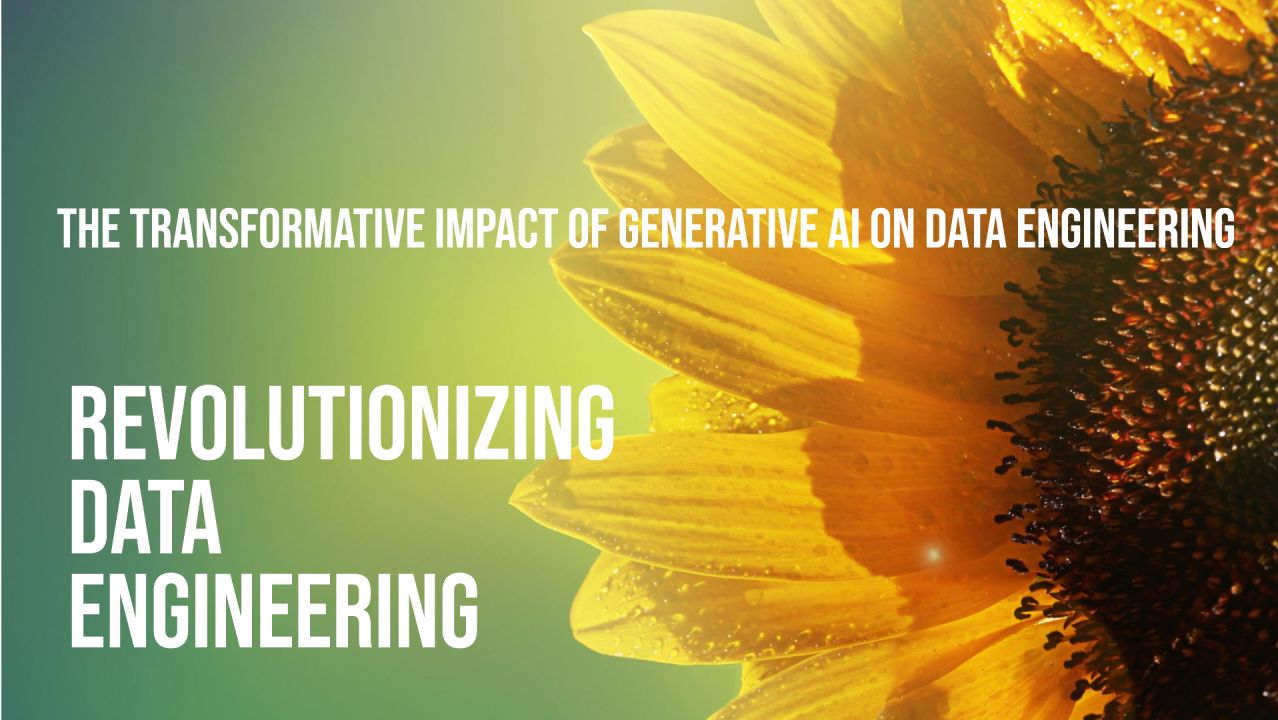
The Transformative Impact of Generative AI on Data Engineering
Kumar Preeti Lata
Microsoft Certified: Senior Data Analyst/ Senior Data Engineer | Prompt Engineer | Gen AI | SQL, Python, R, PowerBI, Tableau, ETL| DataBricks, ADF, Azure Synapse Analytics | PGP Cloud Computing | MSc Data Science
Generative AI is at the forefront of technological innovation, significantly impacting various industries, including data engineering. As organizations strive to become more data-driven, the integration of generative AI into data engineering processes offers unparalleled opportunities for efficiency, innovation, and enhanced decision-making. This two-page exploration delves into how generative AI is reshaping the data engineering landscape, focusing on the construction of data pipelines, the merging of roles within data teams, the management of unstructured data, and its implications for data-driven decision-making.
1. Building Pipelines with Generative AI
Traditionally, data engineering involved manual coding and intricate designs to create data pipelines that process, store, and analyze vast amounts of data. However, generative AI is changing the game by automating several aspects of pipeline development. With AI-driven tools, data engineers can leverage natural language processing (NLP) to convert high-level specifications into code, reducing the time spent on repetitive tasks.
For example, engineers can describe the desired functionality in simple language, and generative AI can automatically generate the necessary SQL queries, data transformation scripts, and even API integrations. This not only accelerates the pipeline development process but also minimizes human errors associated with manual coding. By automating mundane tasks, data engineers can focus on high-level architecture and design, leading to more innovative solutions.
Moreover, generative AI enhances the testing and validation of data pipelines. It can simulate various data scenarios, ensuring that the pipelines handle edge cases effectively. This proactive approach to quality assurance helps in delivering robust data solutions faster, ultimately benefiting the entire organization.
2. Collaborative Analytics: Merging Roles
One of the significant shifts brought about by generative AI is the blurring of roles between data engineers and analysts. In the past, these roles were distinctly separate, often leading to communication gaps and inefficiencies. However, generative AI fosters collaboration by enabling a shared understanding of data.
As generative AI tools become more user-friendly, data analysts can engage in tasks traditionally reserved for data engineers, such as writing data transformation scripts or designing data models. This democratization of data engineering empowers analysts to take a more active role in the data pipeline process, allowing for quicker insights and faster iterations.
For instance, analysts can use generative AI to create visualizations or dashboards based on the data pipelines built by engineers. This seamless collaboration not only speeds up the analytics process but also encourages a culture of innovation, where team members contribute their unique perspectives to data projects.
3. Unstructured Data Management
The increasing prevalence of unstructured data—from social media posts to multimedia content—poses a challenge for traditional data engineering practices. Generative AI excels in processing and analyzing unstructured data, making it an invaluable tool for data engineers.
领英推荐
With the rise of technologies like Retrieval-Augmented Generation (RAG) and vector databases, generative AI can efficiently extract insights from unstructured sources. RAG, for example, combines the power of generative models with retrieval systems, enabling users to query large datasets for specific information. This capability is particularly beneficial for organizations seeking to derive actionable insights from diverse data sources.
Furthermore, generative AI can aid in data cleaning and preparation by identifying anomalies, suggesting corrections, and automating the transformation of raw data into usable formats. This streamlining of the data preparation process saves valuable time and resources, allowing data teams to focus on analysis rather than data wrangling.
4. Enhancing Data-Driven Decision-Making
At the core of every data-driven organization is the ability to make informed decisions based on reliable insights. Generative AI enhances this decision-making process by providing predictive analytics and advanced modeling capabilities. By analyzing vast amounts of historical data, generative AI can identify patterns, trends, and correlations that may not be immediately apparent to human analysts.
For instance, in industries like finance or healthcare, generative AI can analyze customer behavior, market trends, or patient outcomes to forecast future scenarios. These predictive insights enable organizations to make proactive decisions, ultimately leading to better outcomes and competitive advantages.
Moreover, the integration of generative AI into business intelligence tools allows for real-time reporting and dynamic dashboards. Stakeholders can access up-to-date information, enabling them to respond quickly to changes in the market or operational environment. This agility is crucial in today's fast-paced business landscape, where decisions need to be made swiftly to stay ahead of the competition.
Generative AI is undoubtedly transforming the field of data engineering, offering innovative solutions to enhance efficiency, collaboration, and decision-making. By automating pipeline development, merging roles within data teams, efficiently managing unstructured data, and providing predictive insights, generative AI empowers data professionals to unlock the full potential of their data.
As data engineers and analysts embrace these advancements, they must remain adaptable and open to continuous learning. The future of data engineering lies in the successful integration of generative AI, fostering a culture of innovation and collaboration that will drive organizations toward data-driven excellence.
In this rapidly evolving landscape, it’s essential for data professionals to explore how they can leverage generative AI to enhance their workflows and deliver value to their organizations. The journey may be challenging, but the rewards are significant—transforming how we work with data and ultimately leading to more informed decision-making in all aspects of business.